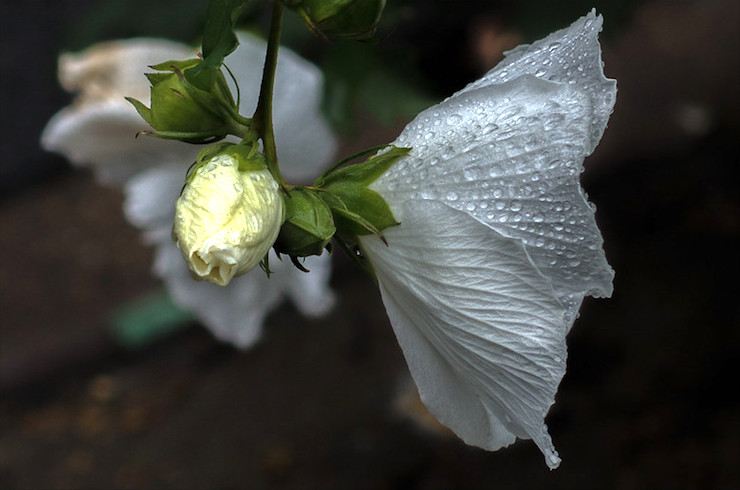Poet-a-Day: Meet Murray Silverstein
I hadn’t known Murray Silverstein before conducting my Great Sestina Hunt for How to Write a Form Poem. I’m so glad to have met him through his moving poem, “Sestina to Bind a Goodbye.” As a mother of three children who are growing up way too fast, the poem hits home in a powerfully understated way.
Besides his sestina, Silverstein’s a pretty cool guy. He sent me a copy of an anthology he edited for Sixteen Rivers Press called America, We Call Your Name: Poems of Resistance and Resilience. “American, listen to what your poets are saying,” he writes in the Introduction. I believe America would do very well with that advice.
Here are the first two stanzas from “Sestina to Bind a Goodbye” to get you hooked. You can read the rest in his collection Any Old Wolf, and, of course, How to Write a Form Poem.
Sestina to Bind a Goodbye (excerpt)
When morning rose on the old blue car
parked in front of the shingled house,
the people inside were already up: the father
making coffee for the road, the mother
at the table, trying to wrap a globe,
and the daughter, combing out her knots.
The father, too, was thinking of knots,
his job to tie to the top of the car
the overflow of stuff. He eyed the globe.
“Are we going to clean out the house?”
he said. Testy today, the mother
thought, but said, “She asked—” and the father …
—Murray Silverstein
Tania Runyan (TR): Tell me a little about the origin story of “Sestina to Bind a Goodbye.”
Murray Silverstein (MS): After a summer at home, our daughter—our youngest—was heading off for her third year of college. Setting off early, for a road trip with a pal, we suspected (and it turned out we were right) that this time she might be leaving for good. Helping her pack the car my wife and I were, all at once, anxious, thrilled for her, and sad. Childhood, long over in fact, was now officially done. Could she take, she asked, the old family globe?
TR: Why did you choose the sestina form for this occasion?
MS: Ever since reading Elizabeth Bishop’s “Sestina,” the form has fascinated me, and I’d always wanted to give it a try. It’s both a fixed form—with its six stanzas of six lines each, the repetition of end words in a prescribed pattern, and a final stanza of three lines in which the six words are repeated—and, at the same time, as no particular sequence of rhyme words is required, a relatively open form. And this blend of freedom and constraint, seemed to fit the occasion: a daughter, leaving the fixed form of family life behind, sets out for the open road.
As I worked on the first stanza, and began to find my end words—car, house, father, mother—the word daughter, I assumed, would be one of the six. But I couldn’t make that work. It was as if the form itself kept saying, No, and it eventually dawned on me that not including “daughter” as one of the key words, conveyed the idea of letting her go. She was leaving the familiar pattern, behind.
So what would the sixth word be? Knot, it turned out: tying, untying, retying family knots … until the anxious father, tying the gear to the roof of the car, says (giving expression to his unconscious wish), “This puppy’s not / going anywhere.”
TR: What do you think poets can learn from a book like How to Write a Form Poem?
MS: I would be fascinated by a book about form that helped me explore the ways that poetic forms can help us contain and give shape to complex emotions. When I found the title, “Sestina to Bind a Goodbye,” it was the word “bind” that caught my eye. I think I was trying to say that the form itself had helped me to contain, give manageable form, to otherwise chaotic feeling. Paradoxically, by helping to hold a sorrow, it was helping me to deal with it and let it go: “the thrill of loss hung over the house, / . . . but too, the thrill of finding.”
About Murray Silverstein
Murray Silverstein is the Senior Editor of the anthology, America, We Call Your Name: Poems of Resistance and Resilience (2018), winner of Independent Publisher’s Silver Medal for Poetry, and The Place That Inhabits Us: Poems of the San Francisco Bay Watershed (2010), both from Sixteen Rivers Press. He is the author of two books of poetry, Master of Leaves (2014) and Any Old Wolf (2007), also from Sixteen Rivers. Any Old Wolf received Independent Publisher’s Bronze Medal for Poetry.
His poems have appeared in Rattle, Brooklyn Review, Spillway, Poetry East, West Marin Review, RUNES, Nimrod, Connecticut Review, Zyzzyva, California Quarterly, Fourteen Hills, Pembroke Magazine, Elysian Fields and other journals. A retired architect and co-author of four books about architecture, including A Pattern Language (Oxford University Press), and Patterns of Home (The Taunton Press), Silverstein lives in Oakland, California.
Hear Murray Read “Sestina to Bind a Goodbye”
(go to 1:15:34 to hear Murray read)
Photo by Levon Avdoyan, Creative Commons, via Flickr. Post by Tania Runyan.
Browse more Poet-a-Day
Browse 50 States of Generosity
Check out The Yellow Wall-paper Graphic Novel
BUY ‘HOW TO WRITE A FORM POEM’ NOW!
- Flowers of California: California Poppy - December 8, 2022
- Flowers of California: Lily of the Nile - October 13, 2022
- Flowers of California: Crape Myrtle - October 5, 2022



Bethany Rohde says
“I think I was trying to say that the form itself had helped me to contain, give manageable form, to otherwise chaotic feeling. Paradoxically, by helping to hold a sorrow, it was helping me to deal with it and let it go . . .” Thank you for this.
I enjoyed listening to the reading of the full poem on Saturday. I’m planning to read more of Murray Silverstein’s work.
Tania Runyan says
Murray’s reading was a highlight. So good! Beautiful, funny, and heartbreaking poem.